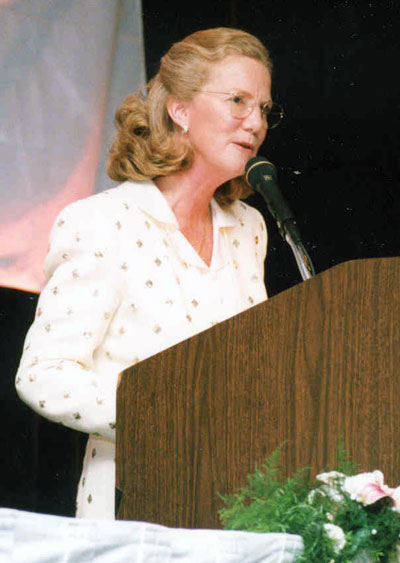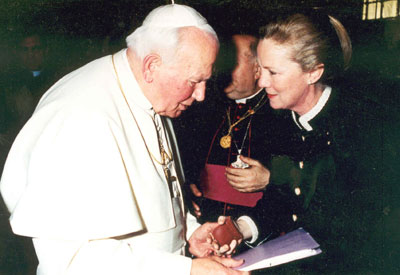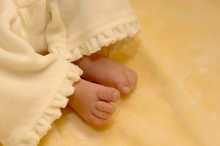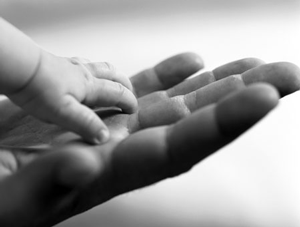
Motherhood at the Heart of the New Feminism: A Vocation of Love and Service
Address Offered by Mary Cunningham Agee
International Conference on Women: Women and Family and Career
Pontifical Athenaeum Regina Apostolorum, Rome, ITALY
Whe n Americans are invited to speak at international gatherings such as this, we are typically relied upon to supply down-to-earth, practical advice. Our entry into a program tends to signal an audience to settle back and ease up from the more rigorous philosophical considerations of the day and prepare to glean a few clever, problem-solving tips.
n Americans are invited to speak at international gatherings such as this, we are typically relied upon to supply down-to-earth, practical advice. Our entry into a program tends to signal an audience to settle back and ease up from the more rigorous philosophical considerations of the day and prepare to glean a few clever, problem-solving tips.
Americans, after all, are supposed to be a nation of pragmatists, the inventors of the latest labor-saving gadgets, the efficiency experts, the “how to” gurus of this over-worked, time-constrained world. Corporate America prides itself on being the birthplace of the “pert chart” and the infamous “bottom line.”
And so, when it comes to grappling with today’s provocative topic, the contemporary woman’s challenge to find personal fulfillment in achieving a balance between family and career, it might seem like second nature for us to try to reduce this presentation to a practical little list of handy “do’s and don’ts.”
Despite my years at Harvard Business School and as a Strategic Planning Vice President for two Fortune 100 companies, I am hoping to use our time together today in a very different way. I do not believe that our topic lends itself very well to simplistic checklists or tidy “how to” reminders. I’ve seen too many of my female friends worn out and disillusioned by trying to conform to a false image of “superwoman” in pursuit of an equally unrealistic ideal of “having it all” simultaneously.
A New Perspective:
Now that I am 50 years old and immersed in the challenging process of guiding my vibrant 16-year-old daughter through the labyrinth of her own life-altering choices, I am moved to speak to you today from a slightly different and, hopefully, more candid perspective. It is the perspective of one whose words are born of life’s rich experiences, of one who hopes to give to you what no one seemed able or prepared to give to me when I was facing these issues a few years ago. I am hoping to speak to you today as more than just another professional woman who has managed to achieve a reasonable balance between a fulfilling career and a very meaningful home life. Rather, I plan to speak to you today from the more heartfelt perspective of an empathic friend. You might say that I will be speaking to you as a mother.
So let’s spend no more than a few moments addressing a few facts and figures that dramatically convey the intense challenge of contemporary woman’s situation. Recently, the Washington Post reported the reassuring results of a study of the sleeping habits of 1.1 million Americans. Surprisingly, the analysis showed that people sleeping only six to seven hours nightly actually tended to live longer than those who slept eight or more hours nightly. [Washington Post, 2-14-02] I suspect that most of the women in this audience are hoping that this research turns out to be true, because as we all know so well, crowding everything in that needs to be done in a day doesn’t leave much room for eight or more hours of downtime daily.
In case you are wondering if you are just imagining your chronic state of fatigue, a 1999 study in the Journal of Health and Social Behavior [March 1999, by  Chloe E. Bird] documented that American married women in fact work 14 more hours weekly than single women, while married men only work an additional 1 ½ hours. And a recent Canadian study by GPI Atlantic [March 1998, updated in 2000] went so far as to estimate that the total yearly market value of Canadian women’s unpaid cooking, cleaning, and child-rearing amounted to about 275 billion Canadian dollars! By most calculations, women working both inside and outside the home are conservatively estimated at putting in an average work week of 73 hours. Similar studies estimate that single employed mothers work at least 75 hours a week, with literally only one hour a day free for so-called “quality time” with their own children!
Chloe E. Bird] documented that American married women in fact work 14 more hours weekly than single women, while married men only work an additional 1 ½ hours. And a recent Canadian study by GPI Atlantic [March 1998, updated in 2000] went so far as to estimate that the total yearly market value of Canadian women’s unpaid cooking, cleaning, and child-rearing amounted to about 275 billion Canadian dollars! By most calculations, women working both inside and outside the home are conservatively estimated at putting in an average work week of 73 hours. Similar studies estimate that single employed mothers work at least 75 hours a week, with literally only one hour a day free for so-called “quality time” with their own children!
Statistics such as these suggest what many frantically busy modern women have already intuited–that the schedules we have imposed upon ourselves daily are, if not impossible, at least improbable. In our struggle to fulfill ourselves, our family obligations and our job descriptions, we have only succeeded in filling up our day planners while allowing ourselves to be pulled in too many different directions to even begin to experience any kind of personal fulfillment.
If we sincerely want to explore the question before us, then number crunching and efficiency gadgets will not take us nearly far enough. I recommend that we put away our calculators and calendars and reflect upon this topic in a whole new way. As an American woman who devoted most of her undergraduate years to studying not Economics or Business but Logic and Philosophy, I am struck by how much more these disciplines may have to offer than the more obvious management courses that I studied at Harvard Business School. This is true because any meaningful consideration of today’s topic requires us first to address the most profound inquiries into the nature of man and woman and the meaning of life. It will be upon these foundational insights that we will then be able to provide solid, consistent responses to the full array of life’s daily choices.
So, when we look at the complex relationship of modern woman and her unique role in both work and family, and think about how to make the complicated choreography of her life function effectively, we must begin by asking such fundamental questions as: What is the true nature of a woman? What are her innate strengths and weaknesses? How ideally should her life interface with that of her partner, man? What is her ultimate end, the “telos,” for which she was created. And how is she best suited to attain this?
At this point I must share my personal conviction that the most complete answers to all of the human heart’s deepest questions will always and necessarily be found in the life and teachings of Jesus Christ, the Son of God, our Creator. Fortunately, as Catholics living, working, and reflecting during the fruitful pontificate of our beloved Pope John Paul II, we can draw upon an abundance of insightful materials to help us better understand our unique purpose and identity as women as we contribute our particular gifts at the opening of the third millennium.
The Nature of Woman:
And so let us ask, what are the primary characteristics of female nature and what kinds of careers or professional tasks will enable us to fulfill this unique calling? Most of us, I would hope, have gotten over--or should I say gotten past--that peculiar brand of 1960s and 70s feminism that stridently tried to assert that there is no difference between men and women. Although we all know that there is virtually no occupation or preoccupation that a woman cannot accomplish successfully, we have also come to recognize that certain categories of work or professional occupation more comfortably conform to a woman’s nature.
Let me direct you to the particularly perceptive words spoken by then-Bishop Karol Wojtyla to Polish women university students in 1962 [The Way to Christ: Spiritual Exercises, Pope John Paul II, Karol Wojtyla, tr. by Leslie Wearne, Harper, 1984, p. 35, 37]: “Let us consider a woman’s interior character as compared with that of a man’s. ...Christ understood this difference perfectly – women are more feeling and intuitive people and become involved in things in a more sensitive and complete manner. ...[W]oman is first and foremost a mother. A mother is the person who generates, which means bringing up–and bringing up not only children–with love and intuition. Her basic task is that of educating. Jesus Christ, the Son of God, God made man, allowed himself to be educated by a woman.”
Given this unique purpose and capacity, it seems reasonable to assume that the way women combine their roles within and without the family will differ essentially from the way men do so. In order for this way to be joyful, sustainable and productive, it must conform to her nature. This holds true whether women are simultaneously mothers and professional women, or single and childless, or engaged only in professional careers. Being true to our nature as women is essential to our integrity, to our wholeness, to our ability to experience joy. Like all human beings, we need to “act out” who we are, expressing ourselves and at the same time forming ourselves by our actions. As the English Jesuit poet, Gerard Manley Hopkins, put it, “What I do is me: for that I came.” [“As Kingfishers Catch fire, Dragonflies Draw Flame”]
The way in which a woman does what she does will be just as surely an expression of her feminine nature as what she does. This is true in such seemingly superficial matters as dress and deportment; for this is her style. But it is even truer at a deeper level for which style is a sign or sacramental working out of differences which arise from an inner orientation that expresses her own unique feminine psychology.
We know that most women at some point in their lives choose to marry and bear children and nurture them. In choosing the great rewards and challenges of family life, as wife and mother, a woman finds ample opportunity to express the profoundly feminine part of herself, simultaneously serving others and developing her potential for greater love, greater service, greater fruitfulness and, ultimately, a greater expression of herself. In an especially moving passage in Mulieris Dignitatem [Part VI], the Holy Father poignantly describes women’s unique contribution to this human enterprise:
“Motherhood implies from the beginning a special openness to the new person: and this is precisely the woman’s “part.” In this openness, in conceiving and giving birth to a child, the woman ‘discovers herself through a sincere gift of self.’ Parenthood–even though it belongs to both [father and mother]–is realized much more fully in the woman, especially in the prenatal period. ...Motherhood involves a special communion with the mystery of life, as it develops in the woman’s womb. The mother is filled with wonder at this mystery of life, and ‘understands’ with unique intuition what is happening inside her. …This unique contact with the new human being developing within her gives rise to an attitude towards human beings–not only towards her own child, but every human being–which profoundly marks the woman’s personality. It is commonly thought that women are more capable than men of paying attention to another person, and that motherhood develops this predisposition even more.”
Let’s consider what all of this means for us, not only for those among us who are mothers at home caring exclusively for families, but for those who are mothers also contributing their gifts in the world -- whether working for pay, volunteering, or simply interacting with others. “Attention must be paid,” cries out Willy Loman in Arthur Miller’s tragic play Death of a Salesman. Yes, indeed, attention must be paid to all of the seemingly “un-special” people who constitute always and everywhere the overwhelming majority of the human race. And who, according to Pope John Paul, is best equipped by nature to render this deeply humane and humanizing attention? Who is best equipped to respond with sensitivity both to expressed needs and to those hungers and yearnings betrayed by a tone of voice, a look in the eyes, slumped shoulders and heavy sighs? The answer is that we are, as women, because of our acute awareness of the other and, if you will, our more sensitive social antennae that are always alert to the most subtle emotional and psychological vibrations.
We must also acknowledge that we as women are in the most biological sense of our identity “receptive.” Our bodies are indisputably hard-wired to receive the male sperm in order that the human race might continue. But I hasten to add that this receptivity should in no way be confused with any notion of “passivity.” For again, returning to the facts of biological science, we observe that once the sperm unites with the egg, the womb immediately focuses it energy on creatively nourishing the zygote, actively providing it with everything it needs to foster and promote new life. And, as every mother in this audience can appreciate, this pattern continues long after birth. For It is the mother, the woman who harbors life within her, nurturing and nourishing her unborn child. And after giving birth, it is the woman again who typically continues to nurture her children in ever-evolving ways, seeking to understand and encourage her offspring in all of their awesome originality.
I believe that this physical and maternal capacity to actively receive, embrace, nourish and nurture new life has as its analogue a similar feminine professional ability to “receive” those around her—that is to receive and nourish the ideas of those around her. It is worth noting that men often grapple with ideas in a way that suggests images of wrestling. We remember Jacob, for instance, wrestling with the angel all night for mastery. Men attempt to “master” knowledge and ideas–perhaps a reflection of their mandate to subdue the earth. We have all observed the masculine tendency to throw out challenges to a new concept or argument, more or less testing its worth in a sink-or-swim, survival-of-the-fittest way.
If men are busy “subduing” the earth, then I believe, by contrast, that we women seem to take heart from the injunction to “fill” it. We are more likely to receive ideas as something to assimilate to our own world view. Other people’s ideas actually become a form of nourishment to us. This does not mean that we uncritically accept whatever we are told, but rather, that we are more inclined at least to meet a new concept halfway. By nature, we have a tendency to help an idea along by rephrasing it more convincingly, unearthing supporting evidence or proofs, encouraging the originator of a new concept by reformulating and expanding upon an embryonic idea. We professional women tend to be well-disposed toward seeing other people’s intellectual offspring succeed, rooting for them like a mother encouraging her child to take his or her first steps.
Qualities such as these clearly find a warm reception in traditional “female” careers like education, care of the young, the service and health professions. But I also believe that these qualities accommodate themselves well to many of the less traditional professional settings. I have experienced first-hand how helpful and appreciated this quality of welcoming new ideas, new methods, and new people can be in the typically male dominated and competitive corporate world. I have often found that offering colleagues a chance to prove themselves by expanding creatively on their newly conceived suggestions is as important in building a loyal, effective management team as testing how well they will hold up under the pressure of defending themselves against conflicting opinions.
The unique qualities and strengths of women, then, can and do find meaningful expression in a wide variety of professional careers and activities. Therefore, the real problem faced by busy wives and mothers today who take on substantial professional responsibilities, whether by choice or by necessity, is not how to reconcile the demands of these tasks with their female nature. Nor is it primarily a matter of figuring out how to handle the obvious challenge of time-management. No, I believe the key issue for modern women goes back to the more philosophical question of setting appropriate and sustainable priorities. For me, this has meant nothing less than identifying the fundamental difference between a “vocation” and a “job.”
The Primacy of our Vocation to Motherhood:
If, as the Holy Father says, women are by nature mothers, then those of us who have chosen the vocation of being a wife and / or mother must whole-heartedly embrace the primacy of this role in defining our true identity. This necessarily and most practically translates into a generous sharing of our most limited and precious gift of time. We must see through the utilitarian rationalization that would attempt to silence our conscience by saying, “You are using your womanly nature to mother and nurture other people, projects, and causes that affect many more people’s lives, so the lives that you share at home will just have to make the sacrifice of doing without you for the greater good of others.”
It’s true that families are meant to channel generous amounts of their love, energy, and talent outwards, in service to the world around them. But family and marital commitments, once entered into, must still be regarded as primary, for they constitute a genuine “vocation”– or “calling” from God. A vocation – unlike a job – actually transforms the terms of one’s life. It establishes binding covenants, in this case with husband and children–a far more elemental tie than any business or social contract. Covenants, after all, involve an exchange of persons, while contracts involve merely an exchange of goods or duties.
I have found that when the vocational choice to mother a family is undertaken with a loving attitude of Christian service, it becomes the source of immeasurable creativity and intellectual energy that, in turn, overflows into outsides pursuits as well. However, I have equally found that when a woman tries to deny or compromise her principle vocation, she endangers not only the good of those for whom she is primarily responsible, but also her own physical, emotional and spiritual wellbeing. For she is quite literally cutting herself off from her own nature–frustrating her own natural desire to love and care for those entrusted to her, to be receptive to them, to be fully attentive to their needs, and, in return, to be cherished, to be held in high regard and to be understood and blessed by them.
The immediate question before us today then is: How can a working wife and mother go about achieving a meaningful “balance” between the potentially conflicting public and private demands that result from fulfilling responsibilities both inside and outside the home? As I prepare to reply more fully to this inquiry, I must admit that I do so not from the safe distance of one who has mastered a subject through intense theoretical study – but rather, from the acutely personal and essentially practical perspective of one who has lived her subject matter.
As a dedicated wife, best-selling author, home schooling mother and, at the same time, managing Director of a 32,000 volunteer member charitable enterprise that serves the urgent and practical needs of thousands of mothers in crisis, you might say that my life is living proof that a meaningful balance can be achieved. But I would be failing you miserably if I did not go on to add that maintaining this delicate balance is an intense, daily challenge that requires the utmost of care and self-scrutiny.
To underscore the importance I place upon resolving the basic difference between our vocations and our jobs, I would go so far as to say that there is a kind of “infidelity” committed by those who freely choose the vocation of marriage and family life and then relegate it to second or third place. When a more alluring or ego-gratifying career opportunity comes along, the inevitable “unfaithfulness” to the legitimate needs of loved ones entrusted to us is what inevitably adversely affects a woman’s health and happiness. Naturally, I am not trying to suggest that if a single woman or a woman without children legitimately exercises her choice to work extensively outside the borders of family life that this choice would in any way involve infidelity. Similarly, someone consecrated to the religious life would not be demonstrating any unfaithfulness to his or her nature by forgoing the biological expression of generativity.
I maintain, however, that true fruitfulness both inside and outside the home for those who have chosen the vocation of wife and mother will depend most essentially and quite simply upon keeping the primary vocational commitment in first place. Then, having responding faithfully to her primary responsibility, a woman will be free to let this energy and love–the fecundity of all those relationships–flow out into creative service to others. We can rest assured knowing that there will be plenty of early warning signals to clearly expose when an incorrect attitude or improper performance of responsibilities is taking place.
One sign we may recognize is an impatient, clock-watching mentality that finds us apportioning time to loved ones in a be-grudging way. When this occurs, an insensitive kind of rigidity usually sets in that resists throwing out the pre-planned schedule to make room for the child or spouse who needs not “quality time,” but time pure and simple. These gifts may include time to tag along on an errand, to chatter while you are making dinner, to help you select the clothes you’ll be wearing to work or to assist you while packing. It may translate into something as simple and spontaneous as coming along with you when you walk the dog or just feeling free to interrupt you without having to feel like an intruder.
When we begin to feel as though “real life,” with its supposedly big stakes, is being waged “out there,” instead of at home, the warning lights should start to flash. When we begin to place too much importance on penetrating a new professional inner circle or cracking the “glass ceiling,” these too should be considered early warning signs of an unhealthy imbalance. As most of us have painfully come to recognize, our ambitions for greater success and recognition may often come disguised as a seemingly benevolent desire to better employ our talents or even better aid humanity. A friend of mine who writes extensively on family issues recently joked ruefully about being under a tight deadline and snarling at her children who came tugging at her for a little love and attention, “Scram. Can’t you see that I’m writing about the family?”
By the way, let me hasten to add that this temptation to cheat on our primary responsibilities because of a desire to do “greater” things doesn’t just affect women. Men, too, can throw their lives out of balance without really noticing it, convincing themselves that the world needs their contribution more than their families or that family members need a more affluent lifestyle more than they need the regular presence of a devoted father. And, just as with women, the greater the man and his opportunities are, the greater the temptation. Politicians–even the best of them–are notoriously prone to fail here.
A recent book about former American president Ronald Reagan quotes his daughter Patti Davis, who recalled that she and her siblings, like many children of prominent politicians, often felt that their problems and concerns looked fairly petty next to those of the nation. A flunked test, a friend’s rejection, a part in a school play, a crucial ball game–how small they all seemed when stacked up against the Cold War, abortion and the unemployment rate. And yet, as G. K. Chesterton said of women’s contributions in the home, “Which is more important–to be something to everybody or everything to someone?”
Even in the private sphere, there are ambitions that can interfere with our natural inclination to be nurturing, mothering and self-giving. We may unknowingly begin to judge ourselves, our worth, and our performance by the kind of house we own or its condition. We may, even more tragically, be tempted to judge the success of our mothering by our children’s academic, athletic or social performance, penalizing them with our disapproval if they “make us look bad” by their failures or mediocrity.
The warning signs or tell-tale symptoms of a vocational version of “lukewarmness” and a professional ambition that is out of control include rigidity, impatience and an unmistakable loss of fulfillment or satisfaction. When any job routinely demands excessive, inflexible or inconvenient hours, we must admit that it will not be conducive to a well-balanced or fulfilling personal life. Similarly, any job that requires lots of travel or intense pressures that impact our moods or ability to focus on our family’s needs must be placed at least temporarily off limits by a woman who appreciates the primary significance of her vocation as wife and mother. Other family commitments to care for aged parents or an ailing spouse who may need more emotional or physical support can require similar career decisions as those made by women who are raising children. In such cases, high-powered careers may need to temporarily be postponed or even passed over in order to fulfill our primary vocation.
This is where we as modern women need to be painfully honest as we examine our consciences and trace the source of our daily frustrations and family problems. Every woman experiences the normal ups and downs in her relationships with those in her home, but when she finds herself being chronically drained of any sense of joy in her home and family life, she must be willing to consider the possibility that her vocation may be in conflict with her job. We may be tempted at such moments to conclude that we aren’t very good at the mothering or nurturing role in life. We may be tempted to retreat, half in wrong-headed humility, half in relief, to a professional arena that may seem better suited to exploit our strengths and reward our efforts. But these emotional dodges need to be recognized for what they are and be rejected. In these and all of our prudential judgments, when we are tempted to be either too hard or too easy on ourselves and others, a wise spiritual director can help us to separate sound reasons from dangerous rationalizations.
We must admit that setbacks at home are able to daunt us so much precisely because the stakes are so much higher there, extending to our immortal souls and those of our loved ones. We can change jobs, we can switch careers, and eventually, we can retire–but our primary vocation as wife and mother endures forever and to a particular, irreplaceable family. Even seeming failure in this environment is not as bad as our desertion. As Mother Teresa so often would remind us, “We are not called to be successful, but to be faithful.”
Many, perhaps most, women do not suffer from such temptations to ambition or self-aggrandizement because they do not enjoy the luxury of making such choices. They work because they must in order to feed, clothe and educate their families with whom they wish they could spend more time. They accept the best jobs they qualify for, juggling questions of pay, hours and health plan benefits the best way they can, knowing that they do not have the freedom to express dissatisfaction with their lot. Some of these women have husbands who cannot earn enough money to keep their family going without a second income; some have disabled or unemployed spouses; some experience the special loneliness and pressures of bringing up children in a fatherless household. These women scrub floors or work in factories or at supermarket check-out counters. They do not pretend to be “fulfilled” by their work, though they know the anxious satisfaction of bringing home a paycheck to a house with an empty refrigerator, and hoping it will buy enough food for everyone until the next payday.
I must admit to having a special love and respect for the working mothers I am describing here. For I was raised by a mother who endured these same challenges with an unmistakable optimism and undaunted faith that never left me feeling either unfortunate or unloved. No matter how many hours a woman such as this is forced to work outside of her home, she will find special joy and fulfillment even in the most sacrificial of circumstances if motherhood is still her primary vocation. If love for her vocation is the fire that motivates her through great difficulties, not only will she find her identity in giving and receiving love, but her children will fully respond to this as well. Many children who grow up in relative poverty with mothers who cannot spend as much time with them as they would like, still feel loved, protected, nourished and nurtured. These children feel secure because they know that all of the work, worry and care is for them. These children are very much mothered.
Our Maternal Role Model:
St. Paul tells us that our Father in heaven is the one from whom every father on earth receives his name. For us Catholic women, motherhood must always have an equally special association with the motherhood of Mary, our Blessed Mother. Granted, as Jesus’ mother, Mary had a distinct advantage over all of us. After all, Our Lady never had to deal with backtalk or disobedience or temper tantrums!
The closest she probably ever came to that experience with Jesus probably occurred during the three days that she and Joseph spent searching for their Son after he remained behind in the Temple. Of course, Jesus was certainly not “rebelling” against Mary and Joseph, as our own teens may be inclined to do given their fallen natures. In fact, we recall that the child, Jesus, in this incident was actually practicing true obedience to his Father in heaven. Psychologically, however, we women can imagine the bewilderment and outright panic of His parents, Mary and Joseph, at behavior that must have at first seemed out of character and downright inconsiderate. No other event like this is ever mentioned from Jesus’ childhood. When he returned to Nazareth, we are told simply that Jesus “was subject to them.”
I have often meditated upon this scene wondering if perhaps His mother was a bit on edge for some time after this event. Maybe she was on the lookout for further signs of some change or upheaval in her relationship with Jesus. The pain, fear, and confusion that she must have suffered during those three days of searching were perhaps compounded by a sense that somehow her maternal script had changed. Her normal pattern of family life must have felt permanently altered. I suspect that such feelings may sound quite familiar to all of us imperfect mothers who may be suffering through the growing pains of raising adolescent children.
In a way, Jesus seemed to almost deliberately encourage this view that their relationship was about to change. His mother asked him, with a restraint which must prove to any mother among us that she was, indeed, immaculately conceived, “Son, why have you done this? Look, your father and I have sought you anxiously.” (Luke 2:48) In response, Jesus identified not Joseph, but Someone else as his Father–the Father who had generated Him from all eternity. Of course, both Mary and Joseph already knew that Joseph had not biologically fathered Jesus. But naturally, they were all accustomed to referring to Joseph as Jesus’ father, since he so faithfully had filled that function for the Incarnate Son of God. Both Mary and Joseph must have been stunned; they must have been forced to adjust their previous understanding of their roles since this had apparently never come up before this event.
So Mary and Joseph could not have been experiencing the more common human pain of knowing that their Child had done wrong. Rather, they must have endured a much more difficult human anguish of knowing that their Child must have done right, even though they did not fully understand why. Luke’s gospel account simply says, “These words which he spoke to them were beyond their understanding.” (Luke 2: 50)
Aside from this mysterious episode in their lives, Mary and Joseph and Jesus lived an apparently “normal” home life, though I would have to agree with some of my friends who express sympathy for the most “ordinary” member of this household. After all, despite his sanctity, Joseph was the only “un-immaculate” member of the family. If anything went wrong in that holy household, everyone must have known exactly where to look! But for us women considering today’s topic, it is endlessly instructive to reflect upon the sole female exemplar in this holy family. She alone can show us what a woman can and should be. While we know that we won’t ever directly hit that mark, it surely helps to know at least where to aim or how to get even close.
Mary’s example has singular importance to our discussion today. She had infinite reservoirs of receptivity and sensitivity to God and to others, and a capacity to give and receive love that we can only dream of. Her fiat at the Annunciation was a complete giving of self – past, present, and future -- and the self that she gave we can be certain was wholly pleasing to God. There was nothing she needed to repent for or be ashamed of. Her contemplative capacity to meditate on pregnant words–and on the Word she bore in her own body–is a much magnified example of our own feminine ability to unite ourselves to the words and thoughts of others. We find few details about Mary in the Gospels, but each scene in which she plays a part, I suggest, provides the best clues for each of us as we seek genuine answers about how to lead a truly fulfilling life.
Her sinlessness, her perfection as a woman in no way prevented her from the discomfort of being perplexed as we so often are about God’s deeper purposes. After all, she was not omniscient, and so we read that “she pondered these things in her heart.” How often we, too, must embrace this gift of pondering, of taking into ourselves mysteries far greater than ourselves, of accepting our own inadequacy to understand God’s purposes. How often in our roles as wife, mother and worker, we must be willing to rest in patient quiet with mystery, just as we peacefully rest in the presence of the Blessed Sacrament. We may recall how Our Lord asked three of his favorite male apostles, Peter, James, and John, to “watch with me” in the Garden of Gethsemane, and yet we might also remember that they were unable to keep at bay their human weakness. They fell asleep. Can we doubt for even a moment that our Blessed Mother, though not physically present in that Garden during her Son’s agony, was still watching with Jesus in Spirit?
Throughout her life, Mary pondered the words of God, whether in the Hebrew Scriptures that so influenced her “Magnificat,” or the words that the angel Gabriel spoke to her, or the message of the Magi, or the prophecies of Anna and Simeon in the Temple. She did not treat these words as a code to be cracked; she did not attempt to wrestle meaning from them. She lived with them; she made a home for them in her heart as she made a home for the Divine Word in her womb. I believe that this contemplative attitude towards God -- of loving, trusting acceptance of His will -- is something we women can and must learn from our Mother Mary. It is an awareness that we can learn from every recorded event in her life.
But for now, let us return again to consider the particular lesson that we can learn in the Finding of the Child Jesus in the Temple. We remember that Mary and Joseph had been searching for three days before finding their lost Son, only to, in a sense, “lose” him again by the enigmatic words He spoke to them -- words which must have at least initially seemed to shatter the intimate unity of the Holy Family. His response seems to foreshadow the adult Jesus’ words that “he who loves father and mother more than me is not worthy of Me. And he who loves son or daughter more than me is not worthy of Me” (Matt. 10:37). I believe that Mary and Joseph were being reminded that they were supposed to love Jesus not only as a son, but even more as a teacher, savior and mediator with the Father. Humanly speaking, this was, indeed, a “hard saying,” but Mary cherished these words, too, in her heart, like every other word that issued from the mouth of God. As mothers, as working women, as spouses, we are called to do the same.
Our Professional Role Model:
The wedding feast at Cana offers us yet another, powerful lesson about being authentic, fully-engaged women. On this occasion, we are allowed to see our Blessed Mother in a social setting–a big party. Wedding celebrations in Jesus’ time ran on for many days. Notice that she does not retire to the rooftop to do her daily meditation. Instead, she is actively involved in the most practical needs of those around her. Her empathy and sensitivity to others and her awareness of the emotional undercurrents must have alerted her to the looming crisis in the dwindling wine supply.
Through her behavior in this scene, we can easily imagine Mary with a lifetime of experiences handling many other kinds of practical crises–bringing a good meal to a hungry neighbor, helping to nurse a sick Nazarean or assist a local woman in giving birth, minding a young family for a friend, coming to the bedside of a dying fellow Israelite who, if he had only known it, had lived like Simeon to see “the dawn from on high”–the Messiah–visit him. We have to believe that Mary would be at home with the spiritual works of mercy too–instructing the ignorant, comforting the sorrowing, counseling the doubtful. Imagine having Our Lady available in your hometown as your friend, neighbor, or coworker, and being able to drop by for coffee and a few words of advice and encouragement! This is how we, too, must see those in our homes and places of work who help us, and this is precisely how we are called to help others.
Yes, Mary pondered cosmic matters in her heart, and we as women are lost if we lack this contemplative element too. But she did not have the vocation of a Carmelite. She was in the world, like we are, and the wedding feast at Cana demonstrates this perhaps better than any other. You may ask, what does Mary have to say to us as wives and mothers as we scrub a kitchen floor or cook dinner or bring children to soccer practice or go grocery shopping? What does she have to say to those of us who, whether or not we are wives and mothers, go out to earn a living in the workplace, or operate a business from our home? How do we penetrate the silence of the Gospels to imagine her daily life in details that we can identify with?
A little reflection on what we see biblical Jewish women doing may help us to fill in some of the background of Mary’s days. A woman lights up the dark interior of her home with a lamp and sweeps the floor to find a missing coin; another woman takes leaven and buries it in three measures of flour to make bread. Other women–some of them married–accompany Jesus on his travels. The Samaritan woman at the well has come to fill her water jars. The soldiers at Calvary cast lots for Jesus’ seamless garment, probably woven by his own beloved Blessed Mother. Martha bustles about cooking and serving her guests. The women of Jerusalem weep as Jesus passes them on the road to Calvary. Anna the prophetess spends most of her long widowed life in the temple praying. Another widow gives her mite–all that she has–to the temple treasury; and yet another widow pleads her cause before an unjust judge, who finally relents just to get her out of his hair. Peter’s mother-in-law, cured of a fever, rises to feed Jesus and his apostles. (Now, that’s a familiar sight–the Apostles come home from a hard day of watching Jesus cure the sick, and the first thing out of Peter’s mouth is no doubt, “What’s for dinner?”)
All of these women parade past our view in the Gospels, shedding colorful highlights on what life must have been like in first-century Palestine, but still failing to give us a full portrayal of anything we could think of as a business or professional activity. For that, let’s turn to a passage from the Old Testament about another “Ideal Woman.” Let’s consider the well-known description of the good wife at the end of the Book of Proverbs (31:10-31).
It happens that the good wife in Proverbs enjoys a more comfortable lifestyle than that of the Holy Family in Nazareth. She has plenty of servants, buys fields and plants vineyards, and her husband sits at the city gates with the elders (in Washington we call this a power couple!) But she is a hard worker, a good manager, and a friend to the poor. She is wise and kind and her children “rise up and call her blessed.” (How many of us, mothering teenagers, look forward to that day!)
With a little imagination, there is no reason why we can’t picture Mary, too, running a relatively modest weaving business from her home. (Remember that seamless garment!). Perhaps she helped organize some of the other village women, parceling out piecework among them and arranging orders with the merchants catering to the nearest palace household or Roman garrison. After all, in the Book of Acts, Paul’s convert and associate Lydia is described as a seller of purple dye. While we do not know precisely when Joseph died, Mary could well have found herself for a number of years as the chief breadwinner, at least until Jesus reached an age to fully assume adult responsibilities as a workman. We are free to imagine Mary confronting these kinds of economic stresses and practical challenges, none of which would have found her at a loss for how to deal with them.
In any event, the concluding words of the passage in Proverbs apply better to Mary than to any other woman ever born: “Many women have done excellently, but you surpass them all” (Proverbs. 31:29). While the capable woman in Proverbs is a source of financial gain to her household, the author chooses to emphasize her service to her family and those around her. We are told that she does “good and not evil all the days of her life” (Pr. 31:12); that she “rises while it is yet night, and provides food for her household” (Pr. 31:15). She clothes her household as well as supplying the city merchants; that “she watches over the ways of her household” (Pr. 31:27), which must include caring for and instructing those children who, a few verses later, “rise up and call her blessed.” She is celebrated not only for her industry and managerial skills, but for her wisdom, kindness, and charity to the poor. Most important of all, she is described as a woman “who fears the Lord” (Pr. 31:30.)
On our own, we may feel a bit discouraged at the prospect of even coming close to attaining this womanly model. But, let’s not forget that Mary is the Ideal Woman, and so we should not lose hope of becoming worthy women. For remember that Mary was given to us on Golgotha by her own Son to be our mother. And so she is in a very real sense responsible for bringing us up too. It is part of her maternal job, and we have already seen that she is excellent at everything that she does. If we pay close attention to the advice that she offers to us, we will have every reason to hope that we can more closely come to resemble her.
Let’s return once again to the story of the wedding Feast at Cana, to see what else Mary may be revealing to us about how we as women should conduct our daily life. First, I believe that she is reminding us to take an active part in the life of those around us–both in our families and beyond. We should remember that the wedding feast in Cana would have drawn together every family in Cana and several of the neighboring villages. She is vividly demonstrating for us the importance of being highly alert to other people’s needs and cultivating the kind of generous hearts that will go the extra mile to help others. You will note that rather than judging the young couple or their parents for their poor planning, Mary set about solving their problem. Other guests at Cana may have noticed the wine running out, but my hunch is that they may have been more inclined to exchange a few words of gossip with their friends: “I told Anna that she’d never have enough for that crowd, but they’re so cheap with their money. Do you remember the miserable spread at the older girl’s wedding?”
Unlike this common tendency among us fallen creatures, Mary instead opened her heart to another’s plight. Her own sinlessness and human perfection did not make her any less tolerant of our failings, moral or otherwise. Instead, her superabundantly graced nature took no part in the very things that make us critical of others: defensiveness, guilt, egoism, jealousy, competitiveness, a sense of inferiority, fear.
Let’s focus even more closely on her behavior in this scene. Notice that almost immediately, Mary seems to know what to do. She goes to her Son and Savior, and presents him with the situation. Then she trusts him to do the right thing. After that, she evangelizes. This woman of silence, whom we imagine after Pentecost staying home to cook for St. John, mend his clothes and listen to stories of healings and conversions, speaks her one-sentence sermon–the only recorded command she makes in all of the Gospels: “Do whatever He tells you.”
The Blessed Mother’s Principle Advice:
“Do whatever He tells you.” That was Our Lady’s lifelong rule and it is her primary message to each of us today. Her Son himself made obedience to his heavenly Father the touchstone of His life, the alpha and omega of all His actions. We know that following the Father ultimately led Jesus to the Cross just as it also led His mother as a faithful witness and courageous sharer in all of her Son’s suffering. We realize that Mary’s own suffering had been predicted many years before, in another scene in the Temple in Jerusalem, where she, a brand-new mother, came with Joseph to offer their Son to the Lord. How poignantly relevant this scene is for all mothers. All of us know, deep in our hearts the tormenting truth that our children do not belong to us. The Jewish custom of presenting the firstborn to the Lord made it quite clear to whom these children really belong.
Mary surely needed no reminder of God’s claims upon her child, because of the special circumstances surrounding his conception and birth. But how much else she intuited about this small Messiah’s future mission is not revealed to us. Did she, with her deep meditation on the words of the Jewish prophets, already connect Isaiah’s Suffering Servant with the Messiah’s redemptive role? Her “Magnificat” of jubilant praise gives no clue of this to her cousin, Elizabeth, but Mary may have mercifully chosen to hold back some of the disquieting insights she may already have had about her Son’s mission.
On the other hand, Simeon’s prophecy to the young mother that “a sword will pierce your own soul too” (Luke 2:35) was clearly divinely ordained news of something not fully understood by her before. Mary must have returned over and over again to these words, as she reflected through the years on the great mysteries in her life. She had learned that her Son would suffer greatly and, therefore, her own pain would be immense: When a sword pierces your soul, it doesn’t hurt just a little bit, and it doesn’t get better in short order. Mary was given the prophecy of a pain and anguish that would be mortal for Jesus, and would feel mortal to her too. We again recall that Calvary was actually present in miniature at the Presentation in the Temple, that first place of maternal sacrifice. The two turtledoves (notice two victims --for Mary was to share in the sacrifice of her Son) were handed over as surrogates for the baby that Simeon lifted up in his arms, recalling Jesus’ words that “When I am lifted up [on the cross], I will draw all men to myself” (John 12:32).
But have you ever wondered, as I have, why there were only two victims? Why not three? Where was Joseph in this picture? Joseph, who also must have heard Simeon predicting that a sword would pierce his wife’s soul? Surely at some point in Mary’s reflections on this scene, either then or later, she must have realized something of what this meant. In all likelihood, she must have realized that Joseph would not be there with her at the foot of the cross. She and her Son would already have watched him die. Only a very few of the women who followed Jesus–and, uniquely among the male disciples, John--would find the courage and fidelity to climb Mt. Calvary, but Mary would be essentially alone. Again, what a powerful example is presented to us as women struggling to fulfill so many roles and that so often we must perform alone.
Our Spousal Role Model:
I think sometimes that we are tempted to undervalue the depth of the love between Mary and Joseph and, in so doing, lose a profound opportunity to glean special insight into our own spousal role as wife. We may make the mistake of seeing theirs as mostly a marriage of convenience–with Jesus needing an earthly father and Joseph being drafted for this purpose, a little like Simon of Cyrene carrying the Cross. And then, there is the monumental fact of Mary’s virginity. With modernity’s disordered emphasis on the overriding importance of the sex act, we may again be tempted to draw a false equation: no sex, no deep love.
I believe that this portrayal is inaccurate. After all, Mary and Joseph were betrothed even before the angel’s announcement of Jesus’ birth and Mary had already chosen a life of virginity. That is made clear by her question to Gabriel about how she was to become a mother since she did not “know man.” Mary, therefore, had an immense capacity for love–self-donating, self-emptying love–made fully possible by her sinless state. She loved everyone better than we can love anyone. But that surely doesn’t mean that she loved everyone in the same way and to the same degree. Joseph, the “just man,” was not only privileged by God to guard and provide for Jesus. He was selected to be the Blessed Mother’s devoted husband. He was pre-ordained to breathe Jesus’ air, to hug his son’s body, to lead him in prayer, to model fatherhood in its enfleshed form.
Married women can glean tremendous insight from the awareness that Mary and Joseph must have shared a married love whose purity was matched only by its profundity. After all, they shared the vocation of being the earthly parents of the Incarnate God. Among all those around them, they alone fully understood who Jesus was from his earliest years. They did not need to wait 30 years to hear Peter, inspired by the Holy Spirit, say, “You are the Christ, the Son of God.” All of this must have contributed to the development of an extraordinary bond.
It is for this reason that I believe it was not an inconsequential revelation for Mary to learn, on that fateful day of the Presentation, that this intimate, loving spousal relationship would be interrupted by death before she and her Son would undergo what she may well have thought of as “their” Passion.
We might ask, when precisely did Joseph die? There are a lot of years to choose from between the Finding in the Temple and Jesus’ emergence from his hidden years at about the age of 30. We find no mention of Joseph in the later Gospel references, except to identify Jesus as “the carpenter’s son,” which tells us nothing about when he actually died. Tradition seems to put it late in Jesus’ youth or early in his adulthood, perhaps on the theory that God would have preserved him as the family breadwinner until his Son could take over. That still leaves us room to imagine some transitional period for Mary when she must have functioned as the single parent of an adolescent or young adult. Perhaps certain relatives may have helped out. (Remember in Mark 3:21 we are told that some unidentified relatives who believed that Jesus was out of his mind came to get him.) On the other hand, we know that Jesus personally chose His disciple John to care for His Mother following His death. If there had been a close male relative by blood or marriage, normal Jewish practice would have prompted him to have stepped in.
But, whether or not Mary received help from family members after Joseph’s death, we women can understand that she must have had to manage, as many in this audience may have, without a husband’s emotional and psychological support. Any woman can empathize and identify with this. Single parents are particularly familiar with the loneliness of making decisions for a child without the comforting backup of someone who loves that child just as much. They know the profound quiet of an “empty nest” that’s missing not only the grown children, but the spouse who was supposed to have shared their old age. Across the span of 20 centuries, Mary seems to have seen and understood the profound challenges and deep needs of single mothers. Therefore, the blessed happiness of the Holy Family should never be used to discourage any woman with a seemingly imperfect or incomplete home life from looking to Mary for consolation, advice, and example.
Embracing the Cross:
I believe all that Mary suffered at Calvary is implicitly contained in the familiar scene to which we will now return one last time, the Finding of the Child Jesus in the Temple. This woman to whom we can turn for the keenest insight into our true feminine identity must have sensed the coming Passion–probably not in every detail, but at least psychologically and emotionally. And we should note that she accepted it all, not as a slave accepts a beating, but as a good child accepts what her good Father gives to her. Mary teaches us how to embrace the Cross. She repeatedly did so -- not just in her middle age, on hearing that the Temple guard had arrested her Son, but even as a young woman. As our role model, she is truly a woman for all seasons.
We women can gain much practical advice and lasting encouragement by walking closely with Mary as she bears the particular cross of partial knowledge. Without having prophets conveniently rise up to clue us in on our own future crosses, we, too, know that life will inevitably send us burdens to bear–illness, the deaths of loved ones, betrayals, disappointments, opposition–all kinds of heartaches, swords aimed at our very own hearts. And so we need to learn from the loving courage of Mary that we can meet our crosses not like a dog who cowers before a blow, but like courageous daughters of our heavenly Father, resolved to share out of love our unique part in our own family’s sufferings, our particular part in the living cross.
We may face the cross of an addicted family member, we may confront a physical handicap or debilitating illness, financial hardship, unhappy working conditions, desertion by a husband or loved one, loneliness. Perhaps, like St. Monica, we may even suffer a beloved child’s rejection of the Church.
For me, “embracing the cross” as a woman has not meant practicing a passive, dumb endurance of whatever has come my way. Neither has it meant adopting sackcloth and ashes to let everyone know just exactly what I may be feeling about this earthly life. Rather, it has meant praying honestly and openly about each new challenge or difficulty, seeking to view each and every painful test through Christ’s eyes. It has also meant employing my mind, my heart and my will to put into action the most constructive, positive response – while radically trusting and believing with every once of my being that “all things do work for good for those who love God.” (Romans: 8:28)
If we will each actively take up our crosses in this way, it will make all of the difference in the world—and to the world. Merely enduring pain will only bring the cross falling right down upon our shoulders. Without the transcendent power of a dynamic faith, an active hope and a vibrant love, we truly can feel like we are being buried alive. But when we learn to embrace the cross (which is not to be confused with going out to hunt for more!) we are empowered to embrace Christ’s energy and peaceful vision too. And Christ’s embrace is always healing, always strengthening and ever consoling.
Conclusion:
As we approach the close of our time together, let me leave you with one overriding thought: Mary speaks to us contemporary women of all walks of life very specifically, very personally, very maternally from her place at the foot of the cross, because it was there on Good Friday that she became our mother. “Woman, behold your son....Son, behold your mother” (John 19:26-27). Jesus not only offers us His own mother, but asks us to “behold” her, to contemplate her life, her example, her very person as our model in living a life that will bring us into union with him. To the extent that we fight our crosses, trying to duck unpleasant responsibilities or decide questions of conscience based upon our own preferences or convenience, we will not be following in Her courageous footsteps.
A funny example comes to mind that graphically illustrates my point. Many of the mothers in this audience may recall taking part in a Lamaze or childbirth preparation class. Remember (if you haven’t blocked the whole experience out!) how the instructors would stress that we should not “fight the pain?” We were advised that tensing up and resisting would only make the pains of labor feel worse and take longer. Easy to say, hard to do. You must also recall that they were right! I believe that the same lesson holds true for us when we encounter life’s psychological and emotional pains. “Carrying” crosses like a family member’s addiction or bad behavior or financial difficulties does not mean that we as wives and mothers are being expected to take responsibility for someone else’s bad choices or actions. Rather, it means that we are being invited to learn–maybe over many years of trying!--to better understand each person and every situation in the radiant, forgiving light of Christ’s loving example. We are being encouraged to become more open to our family members as being in Christ’s “distressing disguise,” as Mother Teresa would so often refer to it.
And, as many of us have learned the hard way, once we are able to recognize Christ in those causing us special pain, we can finally begin to be Christ for them. For some of us in certain situations, “being Christ” will mean practicing tough love, as Jesus did with the rich young man who “went away sad.” But for others of us, the purpose of our crosses will not be to suffer as much as possible, but to simply learn to say honestly, when each particular crucifixion is concluded, “Consummatum est”– our task of co-redemptive suffering is accomplished, completed, consummated.
At times, endurance and what we as children were taught to call “offering it up” will be all that we can do–and, therefore, all that we are asked to do. At other times and with other crosses, we may need to actively intervene to help ourselves and others. We may need to research alternatives, consult wise and experienced friends or professionals, endure difficult conversations and make very hard decisions. We may be challenged to change our own lives, open up a new sphere of activity or respond to a new call to service in our lives.
In closing, it occurs to me that since we are in the season of Lent, you could perhaps substitute this talk for the Stations of the Cross that you meant to meditate upon today! But I am also reminded that March is the month of the Annunciation. Let us conclude our time together with one final reflection upon our Blessed Mother by turning to the first recorded event in her life. In this central, defining scene, she encountered and embraced all possibilities, all crosses, crises, epiphanies, and blessings that she was destined to experience. The Annunciation was the reason for which she had been immaculately conceived and the reason for which she was called into this world. At the very moment of her fiat, Mary conceived Jesus–and that means all of Him, including His birth at Bethlehem, His Cross on Calvary, and His empty tomb of Easter. The beginning of the joyful mysteries of the rosary is also the starting place of 15 decades of joy, pain, and glory.
The Life that began germinating within Mary, one Galilean springtime two thousand years ago, brought the entire human race to a new and hope-filled springtime. I recall that in his well-known speech at Gettysburg, President Abraham Lincoln movingly described the United States as “conceived in liberty.” With the conception of Jesus, our Savior, all of humanity was in a very real sense re-conceived in liberty–what St. Paul would later describe as “the glorious freedom of the children of God.” For Mary’s freedom from sin both points to and makes possible our own less spectacular freedom from the imprisoning effects of sin, and our opportunity to attain eternal life.
All of this is possible because Mary -- wife, mother, and faith-filled woman -- freely chose complete and unqualified acceptance of the Divine Will.
This discussion of our topic cannot be concluded without taking a moment to place our particular inquiry in its proper historical context. During the past 30 years or more, many of us have watched in horror as Secular Feminism, along with certain New-Age variants, have attempted to seduce an entire generation of women with nothing less than lies about what constitutes “freedom” as opposed to slavery. Like the serpent in the Garden of Eden, false prophets have promised us modern Eves that we could become like gods, controlling our lives and our bodies, deciding for ourselves the definition of good and evil, “tasting” whatever experiences looked pleasurable, whether or not they were forbidden.
With the aid of contraception and abortion, we have been coaxed to seek love and sexual fulfillment without worrying about any consequences. We have been told that we are now “free” to leave our husbands, “free” to abandon our children to overworked and underpaid caregivers, “free” to pursue power careers that will leave us little time to nurture our loved ones. What a “waste of time,” we have been chided, when we could be out there saving the world or making an impressive salary or impacting world events!
But listen to the contrast of our timeless role model, Mary, at the Annunciation, at the dawn of true human freedom. Her reply: “Be it done unto me according to thy Word.” And the angel Gabriel, who had once heard the rebellious angels cry out, “I will not serve,” was now free to rejoice. Everything would be all right now. The Savior, freely choosing to descend into our human nature, had been freely accepted by “our tainted nature’s solitary boast,” as Wordsworth so aptly referred to Our Blessed Mother.
Because of who Mary was and what she did, we women can look with special confidence toward sharing a destiny almost as splendid as hers. But my clear advice to you is this: that we must follow her essential maternal pattern of loving service in order to do so. Like her, we must be contemplative souls, willing to ponder the mysteries of our lives. We must be “practical idealists,” ever looking out for how we can answer the needs and concerns of others. We must be courageous bearers of life’s many crosses while being resolute believers that Christ will transform senseless pain into redemptive suffering. And above all and encompassing all, we must be open, trusting recipients of our loving Father’s divine will, holding onto this truth which alone will bring us to an authentic and lasting form of fulfillment through the joyful, sorrowful, and glorious mysteries of our lives.

"I believe that this physical and maternal capacity to actively receive, embrace, nourish and nurture new life has as its analogue a similar feminine professional ability to 'receive' those around her— that is to receive and nourish the ideas of those around her."
~ Mary Cunningham Agee

And so let us ask, what are the primary characteristics of female nature and what kinds of careers or professional tasks will enable us to fulfill this unique calling? Most of us, I would hope, have gotten over--or should I say gotten past--that peculiar brand of 1960s and 70s feminism that stridently tried to assert that there is no difference between men and women. Although we all know that there is virtually no occupation or preoccupation that a woman cannot accomplish successfully, we have also come to recognize that certain categories of work or professional occupation more comfortably conform to a woman’s nature.
FROM OUR TNN MAILBOX ...
Dear Mary,
I don't know if you remember me. I came to you in your Osterville office in the summer of 1987, five months pregnant with my son, Jack. I still had two language courses left to complete my BA and you placed me at Regis College and at the home of a wonderful family. I stayed with them for four months until I completed my courses, a couple of weeks before my son was born.
I married my son's father and we celebrated our 20th anniversary last December. I thought you might like to hear an update about my beautiful son. Jack is a junior in college and currently on a six-month study abroad program abroad. He is a double major in Economics and Environmental Studies.
Jack is a ferocious environmentalist and would like to launch an alternative energy company. Will has already launched several small companies throughout his college years. He is also a world traveler and phenomenal photographer.
I'm writing to thank you for the support of you and TNN all those years ago, and wanted to update you on the outcome of the wonderful work that you do!
As for me, I am a psychotherapist now, and founder of a clinical center for the treatment of compulsive sexual behavior. Within the next year or two, I will likely return to get my doctorate.
Thank you again Mary for all the support you offered me so many years ago.
~Fondly, Alison
In our struggle to fulfill ourselves, our family obligations and our job descriptions, we have only succeeded in filling up our day planners while allowing ourselves to be pulled in too many different directions to even begin to experience any kind of personal fulfillment.

"A feminist basis for the group might seem odd because its mission is to provide alternatives to abortion, access to which is a llitmus issue for many female careerists. But Mrs. Agee sees herself providing a truer 'choice' for working women than merely the desperate ending of a pregnancy to salvage a personal future.”
~Tim Ferguson - Wall Street Journal

In choosing the great rewards and challenges of family life, as wife and mother, a woman finds ample opportunity to express the profoundly feminine part of herself, simultaneously serving others and developing her potential for greater love, greater service, greater fruitfulness and, ultimately, a greater expression of herself.
~ Mary Cunningham Agee

To underscore the importance I place upon resolving the basic difference between our vocations and our jobs, I would go so far as to say that there is a kind of “infidelity” committed by those who freely choose the vocation of marriage and family life and then relegate it to second or third place. When a more alluring or ego-gratifying career opportunity comes along, the inevitable “unfaithfulness” to the legitimate needs of loved ones entrusted to us is what inevitably adversely affects a woman’s health and happiness.

FROM OUR TNN MAILBOX ...
Pam turned to TNN for emotional support and practical assistance when loneliness and a deep fear that she could not provide for her child consumed her life. Pam sends frequent updates on her daughter’s life – and never fails to express gratitude for the many ways that TNN provided support at such a vulnerable time in both their lives many years ago.
“Dear Mary, When I became pregnant, you may remember that so many terrible things were spoken over my life and the life of my unborn child that I just wanted to give up. When everything in life seems to be against you, it can be very, very overwhelming. Then one sunny August afternoon. I heard your calming voice on Dr. Dobson’s radio program. At that moment, I knew in my heart of hearts that I had made the right decision to continue my pregnancy. Literally, the next day, I joined the TNN family and my life has not been the same since. It seems only to get better and better as time goes on!
But, the best is yet to come … let me tell you about Alison. You know that many years later, she was chosen to be a Student Ambassador to Britain, Ireland and Scotland. This happened when she was still in elementary school. Well, her successes still keep coming as an adult. She graduated last year with a BS degree in Mathematics. She will receive a degree this year in Biology. Her passion is in public health and she will begin graduate studies in Epidemiology -- Biostatistics at Yale!
I cannot imagine my life without Alison. She is brilliant and it seems like the world is waiting for her to do great things. She recently received a beautiful letter of recommendation from her supervisor at the Center for Disease Control. He wrote: Alison is deeply committed to her studies, has a sharp intellect, a commendable work ethic, excellent interpersonal communication skills and proven ability to work effectively on interdisciplinary teams. I believe that Alison will make a tangible contributions to any project she undertakes, produce high-quality research and become a leader in public health.
This letter helps to explain why I feel so blessed to be her mother and raise a wonderful person from such humble beginnings – all with your encouragement and the support of the Nurturing Network.
By your courage and conviction, you have helped so many mothers guide their children through the unsafe waters of an unplanned pregnancy. As you know, without Moses, we would not have an Easter and without the support of TNN, the success we see in Alison today would never have been possible. I have experienced firsthand the intrinsic value that TNN places on a human life. We are witnessing in Alison today the amazing legacy you have given to this planet for generations to come. With Alison’s success there has been a paradigm shift in her life that will affect her future and the future of her children. TNN is the agent of that change!
It is my hope that when all the children that TNN has helped to nurture are grown up, they, too, will be a beacon of hope for many. The lives they touch will be a direct result of TNN making sure that the most precious and vulnerable among us arrived safely at their appointed destination!
With much love, appreciation and a grateful heart ..."
~ Pam
(TNN Inspirational Counselor)
"I’ve seen too many of my female friends worn out and disillusioned by trying to conform to a false image of 'superwoman' in pursuit of an equally unrealistic ideal of 'having it all' simultaneously."
~ Mary Cunningham Agee
Even in the private sphere, there are ambitions that can interfere with our natural inclination to be nurturing, mothering and self-giving. We may unknowingly begin to judge ourselves, our worth, and our performance by the kind of house we own or its condition. We may, even more tragically, be tempted to judge the success of our mothering by our children’s academic, athletic or social performance, penalizing them with our disapproval if they “make us look bad” by their failures or mediocrity.

“The growth of organizations such as the Nurturing Network which support and promote life and the family is such an encouraging sign in the world today.”
~ Prefect Congregation for Catholic Education in Rome
(TNN Spiritual Advisor)

The warning signs or tell-tale symptoms of a vocational version of “lukewarmness” and a professional ambition that is out of control include rigidity, impatience and an unmistakable loss of fulfillment or satisfaction. When any job routinely demands excessive, inflexible or inconvenient hours, we must admit that it will not be conducive to a well-balanced or fulfilling personal life. Similarly, any job that requires lots of travel or intense pressures that impact our moods or ability to focus on our family’s needs must be placed at least temporarily off limits by a woman who appreciates the primary significance of her vocation as wife and mother.

I believe the key issue for modern women goes back to the more philosophical question of setting appropriate and sustainable priorities. For me, this has meant nothing less than identifying the fundamental difference between a “vocation” and a “job. A vocation – unlike a job – actually transforms the terms of one’s life. It establishes binding covenants,in this case with husband and children–a far more fundamental tie than any
business or social contract.

WOMAN OF COURAGE - "ERIN"
A 25 year old working in France, Erin considered returning home to Arizona for the duration of her pregnancy. This option evaporated when her parents became very assertive about their personal views on what choice Erin should make. Living a continent away and with no support from the father of her baby, Erin found a safe haven in the resources and encouragement provided by the Nurturing Network. In the non-judgmental environment provided by TNN Resource Members and Staff, Erin was able to make a parenting decision that was best for herself and her baby.
A profile of this client's needs include the special challenges that Erin was depressed and alone in a foreign country. She was fearful of the peer pressure for abortion that she would receive if she told her friends about her pregnancy. She was concerned about legal issues with the father of child if she were to take her baby out of the country. Her family was embarrassed by the pregnancy and advocated strongly for adoption – an option that Erin considered very thoughtfully for many months.
Due to strong family pressure, Erin chose to stay in Italy for her pregnancy in order to make an informed, independent parenting choice. TNN provided free legal advice and three Inspirational Counselors whose adoption and parenting experience provided the insight needed for Erin to make her decision to parent. TNN Staff offered many hours of compassionate counseling and practical encouragement.
The result is that a healthy mother is now parenting her son with new friends and resources to guide and assist her. She is making plans to move back to the United States eventually in an effort to open the door to reconciliation with her parents and provide a chance for them to know and love their grandson.
With a brand new outlook on life, Erin writes:
“Dear Mary, I am writing to you on Thomas’s 3rd birthday to thank you again. I am happy and love him so much. I have been thinking about your invitation to be an Inspirational Counselor for TNN and would like to offer my support by email while we are still in Europe. I would love to also be of help by phone when I move back to the US. I was really glad that my mother could come to Italy to visit recently. She loves Thomas and is delighted (!) he is on the planet. All of our family thanks you for your support along when all of this was so confusing.Thanks and God bless!"
~ Love, Erin and Thomas

“When our daughter became pregnant, our family would have been at a total loss without the Nurturing Network. Mary and TNN do their work quietly and effectively.”
~ Business Owners
(Parents of Client and Donors)

When we begin to feel as though “real life,” with its supposedly big stakes, is being waged “out there,” instead of at home, the warning lights should start to flash. Men, too, can throw their lives out of balance without really noticing it, convincing themselves that the world needs their contribution more than their families or that family members need a more affluent lifestyle more than they need the regular presence of a devoted father.
A little reflection on what we see biblical Jewish women doing may help us to fill in some of the background of Mary’s days. A woman lights up the dark interior of her home with a lamp and sweeps the floor to find a missing coin; another woman takes leaven and buries it in three measures of flour to make bread. Other women–some of them married–accompany Jesus on his travels. The Samaritan woman at the well has come to fill her water jars. The soldiers at Calvary cast lots for Jesus’ seamless garment, probably woven by his own beloved Blessed Mother. Martha bustles about cooking and serving her guests. The women of Jerusalem weep as Jesus passes them on the road to Calvary. Anna the prophetess spends most of her long widowed life in the temple praying. Another widow gives her mite–all that she has–to the temple treasury; and yet another widow pleads her cause before an unjust judge, who finally relents just to get her out of his hair.

Given a unique purpose and capacity, it seems reasonable to assume that the way women combine their roles within and without the family will differ essentially from the way men do so. In order for this way to be joyful, sustainable and productive, it must conform to her nature.

We women can gain much practical advice and lasting encouragement by walking closely with Mary as she bears the particular cross of partial knowledge. Without having prophets conveniently rise up to clue us in on our own future crosses, we, too, know that life will inevitably send us burdens to bear–illness, the deaths of loved ones, betrayals, disappointments, opposition–all kinds of heartaches, swords aimed at our very own hearts. And so we need to learn from the loving courage of Mary that we can meet our crosses not like a dog who cowers before a blow, but like courageous daughters of our heavenly Father, resolved to share out of love our unique part in our own family’s sufferings, our particular part in the living cross.
"The Nurturing Network is a multi-faceted diamond. TNN’s mission of practical compassion stands out as a unique opportunity for men and women to assist mothers during a most confusing and critical time in their lives. May you continue to extend helping hands and loving hearts to those in need.”
~ US Senator
(TNN Donor and Inspirational Counselor)

"We cannot sustain a civilization if we don’t uphold the dignity of the family. Through your leadership and hard work, the Nurturing Network has become a powerful force in our culture and society. When you are doing good things you attract others to that goodness.”
~ Director of Youth Education
(TNN Inspirational Counselor)

ROMERO PRAYER
"It helps, now and then, to step back and take the long view. The kingdom is not only beyond our efforts, it is beyond our vision.
We accomplish in our lifetime only a tiny fraction of the magnificent enterprise that is God's work. Nothing we do is complete, which is another way of saying that the kingdom always lies beyond us.
No statement says all that could be said. No prayer fully expresses our faith. No confession brings perfection. No pastoral visit brings wholeness. No program accomplishes the church's mission. No set of goals and objectives includes everything.
This is what we are about: We plant seeds that one day will grow. We water seeds already planted, knowing that they hold future promise. We lay foundations that will need further development. We provide yeast that produces effects beyond our capabilities.
We cannot do everything and there is a sense of liberation in realizing that. This enables us to do something, and to do it very well. It may be incomplete, but it is a beginning, a step along the way, an opportunity for God's grace to enter and do the rest.
We may never see the end results, but that is the difference between the master builder and the worker. We are workers, not master builders, ministers, not messiahs. We are prophets of a future not our own"
~ Written in memory of Archbishop Oscar Romero
FROM OUR TNN MAILBOX ...
Maria contacted TNN for help when her family and boyfriend insisted she terminate her pregnancy. She was in college and planned on adoption. She was offered a Nurturing Family who provided the support and encouragement so desperately needed. When Maria realized that she had the emotional and financial means to parent her child, TNN volunteer Resource Members offered Maria and her baby daughter a room in their home until after graduation. This provided the security and tangible resources that Maria needed to meet both her educational and maternal goals. Maria now has an MBA and credits TNN for being “my saving grace.” Two recent photos and one from our TNN scrapbook capture Maria’s joy and gratitude:
“Hi Mary, Thank you for your email and update on TNN’s 30th anniversary plans. You, your family, and your staff have helped so many over the past 30 years. I am eternally grateful for the help you provided Briana and me over 22 years ago. Briana is scheduled to begin nursing school in May. She has been such a blessing in my life. I can’t imagine what my life would be like without her.
I’ve attached a couple of recent pictures we took in Disneyland this past Christmas. It was my youngest three children’s first time at Disneyland, and we had a magical family vacation.
You, your family, and everyone involved with TNN will continue to be in my thoughts and prayers – forever."
~ Love, Maria
(TNN Inspirational Counselor)
"If men are busy 'subduing' the earth, then I believe, by contrast, that we women seem to take heart from the injunction to “fill” it."
~ Mary Cunningham Agee

